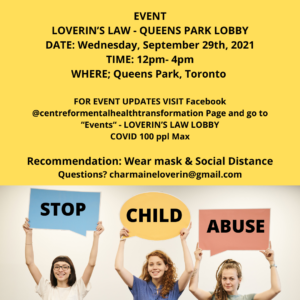Written By: Amy Tai, Program Assistant, Community and Justice Services Diploma (c),
An important part of being a parent is nurturing and raising up our children to be kind, smart, and logical decision-makers. Teaching our kids to not touch a hot stove will teach them not to ignore obvious signs of danger. Teaching our kids to love and embrace who they are will teach them to love and embrace others as they are. We know the reality of the hurting world that we live in. We know of all the pain and suffering to be found. So, we do our best to prepare and protect our children from the evils of the world.
Sometimes it may feel easier to ignore the bad things and shelter our children in a desperate attempt to protect them from any harm. But other times, no matter how hard it may be to introduce them to the broken ways of the world, it is necessary.
Child sexual abuse is a serious problem affecting far too many children and families across the globe. Approximately 1 in 3 girls and 1 in 6 boys will experience some form of sexual abuse before the age of 18 (Little Warriors, 2021). But this is just the tip of the iceberg as nearly 95 percent of child sexual abuse cases are thought to go unreported (Little Warriors, 2021). Child sexual abuse affects children of all ages, regardless of ethnicity, socio-economic status, education, or gender. The hard truth: no child is completely immune to the risk of sexual abuse, however, through education and awareness, the risk can be significantly reduced.
Education is the key to preventing child sexual abuse from occurring. Just knowing about the risks is not enough. To prevent and reduce the risk of sexual abuse for children in your life, it is crucial to fully understand the signs and symptoms, common myths and misconceptions, and be able to have open discussions with your children. While this can be uncomfortable or maybe even feel wrong, talking about sexuality and sexual abuse is a major key in prevention. It can help foster a healthy and safe adult-child relationship which makes it easier for a child to reach out for help and disclose abuse when it happens. Having this knowledge gives children an understanding of what’s happening and why it’s wrong as well as the proper language to disclose and express their feelings.
A child who has been sexually abused is at risk of experiencing a range of behavioural, physical, emotional, and psychological difficulties, some of which can extend well into adulthood if untreated. These difficulties include depression, anxiety, drug and alcohol abuse, overwhelming feelings of guilt, shame, and self-blame.
What are the signs?
The signs and symptoms of child sexual abuse can present themselves physically, behaviourally, and emotionally.
Sexually transmitted infections and signs of trauma to the genital area, such as unexplained bruising or blood on the sheets, underwear, or other clothing, are physical signs of sexual abuse (Warning Signs for Young Children | RAINN, 2021).
Secret keeping, resuming behaviours they had grown out of (bedwetting, thumb sucking), avoiding removal of clothing to change or bathe, and fear of being left alone with certain people are all behavioural signs (Warning Signs for Young Children | RAINN, 2021).
Finally, changes in eating habits, mood, or personality, excessive worry or fear, an increase in unexplained health problems such as stomach or head aches, and a loss or decrease in interest in school, activities, and friends are all examples of emotional signs (Warning Signs for Young Children | RAINN, 2021).
What can parents/caregivers do to try to prevent abuse from happening?
The key to prevention is education and communication. Once you have established a full understanding of child sexual abuse and its signs, symptoms, and risks, you will be better equipped to notice when something is off with your child. When this happens, don’t freak out. Pay attention and look into it further. Listen to your child when they reach out. If they tell you that someone makes them uncomfortable, believe them, even if they can’t give you a reason why.
Most importantly, remember that if something does happen to your child, the perpetrator is to blame. Not you, and especially not your child.
“When someone knows that their voice will be heard and taken seriously, it gives them the courage to speak up when something isn’t right. Encourage children to speak up” (How Can I Protect My Child From Sexual Assault? | RAINN, 2021).
References
How Can I Protect My Child From Sexual Assault? | RAINN. (2021). RAINN. https://www.rainn.org/articles/how-can-i-protect-my-child-sexual-assault
Little Warriors. (2021, April 29). Information & Resources. https://littlewarriors.ca/about/information-resources/#:%7E:text=Prevalence%20of%20child%20sexual%20abuse&text=It’s%20estimated%20that%20a%20staggering,is%20thought%20to%20go%20unreported.
Warning Signs for Young Children | RAINN. (2021). RAINN. https://www.rainn.org/articles/warning-signs-young-children

